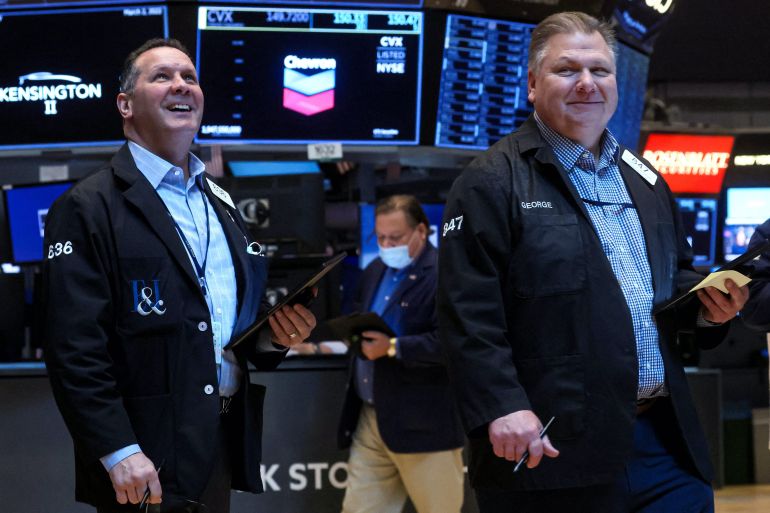Forex
U.S. stocks end lower in week dominated by Powell and rate worries

Key points:
- Main U.S. indexes end down, led by 1% drop in Nasdaq
- All S&P 500 sectors red: utilities weakest group
- Dollar, gold rise; crude off ~0.4%; bitcoin rallies >2%
- U.S. 10-Year Treasury yield falls to ~3.73%
U.S. STOCKS END LOWER IN WEEK DOMINATED BY POWELL AND RATE WORRIES (1600 EDT/2000 GMT)
Wall Street ended lower on Friday, weighed down by losses Microsoft, Tesla and other tech titans as investors assessed the likely path of Fed interest rate hikes and the risk of a recession.
This week’s trading was dominated by U.S. Federal Reserve Chairman Jerome Powell’s testimony to Congress, where he signaled more rate hikes ahead but vowed the central bank would proceed with caution.
Stocks climbed last week after the Fed kept interest rates steady and signaled it would likely raise rates another 50 basis points by year end.
San Francisco Fed Bank President Mary Daly told Reuters in an interview late on Thursday that two more rate hikes this year is a “very reasonable” projection, while echoing Powell’s call for a more caution in policy decisions.
Investors have been betting that improved inflation readings may mean the Fed raises rates only once more in 2023 and that the end of the central bank’s interest rate hiking cycle is near.
Amid uncertainty about the pace of future rat hikes, Tesla dropped 3%, while Microsoft and Nvidia each lost over 1%.
The S&P 500 lost 1.4% this week, and ended a 5-week winning streak. The Nasdaq also lost 1.4% for the week, and snapped an 8-week run of gains.
Still, the SPX is up just over 13% year-to-date, while the Nasdaq is up about 29% so far in 2023.
CHIPS RETREAT FURTHER FROM RECENT HIGHS AS NVIDIA DIPS (1316 EDT/1716 GMT)
Chip stocks are receding further on Friday, with the Philadelphia semiconductor index SOX dropping 1.4%, due in part to losses in Texas Instruments TXN and Nvidia NVDA.
Texas Instruments is dipping 2.4%, while Nvidia, the world’s most valuable semiconductor company, is slipping 0.7%. Nvidia is now down more than 2% since closing on Tuesday at its highest level ever.
Lifted by optimism around artificial intelligence, the SOX has surged 39% in 2023, although it remains down about 13% from its record high close in December 2021.
By comparison, the S&P 500 remains down around 9% from its record high close in January 2022.
Intel is actually gaining about 1% on Friday, and the maker of processors for personal computers and servers is up slightly since Wednesday, when it said its manufacturing business will work like a separate unit and will begin to generate a margin, but gave no clear timeline on when it will start scaling up and announced no new external customer for the business.
INDIVIDUAL INVESTOR PLEASED WITH THE PAUSE -AAII (1215 EDT/1615 GMT)
Optimism pulled back slightly, but remains above average for the third-straight week in the latest American Association of Individual Investors (AAII) Sentiment Survey. With this, bearish sentiment rose from its lowest level since July 2021 last week, while neutral sentiment declined.
Meanwhile, a majority of individual investors felt the Fed’s interest rate pause at its June FOMC meeting was the right thing to do.
AAII reported that bullish sentiment, or expectations that stock prices will rise over the next six months, dipped 2.3 percentage points to 42.9%. This puts optimism above its historical average of 37.5% for the third week in a row.
Bearish sentiment, or expectations that stock prices will fall over the next six months, rose 5.1 percentage points to 27.8%. At three-straight weeks, this is the longest stretch that pessimism has been below 30% since a five-week run that ended in November 2021.
Neutral sentiment, or expectations that stock prices will stay essentially unchanged over the next six months, gave up 2.7 percentage points to 29.4%. Neutral sentiment is below its historical average of 31.5% and is at a six-week low.
With these changes, the bull-bear spread narrowed to +15.1 percentage points from +22.5 percentage points last week. The bull-bear spread is above its historical average of 6.4% for the third-week in a row.
In this week’s special question, AAII asked its members what they thought about the Federal Reserve’s decision to pause interest rate hikes. Here are the responses:
Pausing was the right decision: 67.7%
They should have raised interest rates: 24.5%
They should have cut interest rates: 2.5%
Not sure/no opinion: 5.1%
SERVICES WITH A SMILE, FACTORIES WITH A GRIMACE: FLASH PMI UNDERSCORES DEMAND DIVERGENCE (1100 EDT/1500 GMT)
S&P Global unveiled its initial “flash” June purchasing managers’ index (PMI) readings for the manufacturing and services sectors.
The manufacturing print (USMPMP=ECI) unexpectedly shed 2.1 points to land at 46.3, thereby dipping further into contraction territory and touching a six-month low.
For its part, services activity (USMPSP=ECI) accelerated by a hair, adding 0.1 point to 54.1.
A PMI figure north of 50 indicates monthly expansion; a number below that level signifies a decrease from the prior month.
A side-by-side comparison of manufacturing and services provides a clear indication as to which direction the demand pendulum is currently swinging, and recent data suggests consumers continue to invest in “experiences,” from food and drink services to travel and hospitality.
Taken together, the flash composite lost a bit of momentum, giving up 1.3 points to 53, safely within expansion the zone.
“While improving supply conditions had helped boost manufacturing production in prior months, an increasingly severe downturn in new orders mean factories are running out of work,” writes Chris Williamson, chief business economist at S&P Global Market Intelligence.
“The situation is brighter in the service sector, where demand is proving resilient and the recent pause in rate hikes appears to have helped boost business optimism for the year ahead,” he adds.
Even so, labor market tightness remains a significant headwind for the booming services sector.
“The tightness of the labor market remains a concern, and upward wage pressure remains a key driver of higher costs in the service sector,” Williamson says. “However, it is encouraging to see the overall rate of selling price inflation for goods and services drop to the lowest since late 2020 in a sign that the Fed is winning its fight against inflation.”
Silver lining spotters will note that on the manufacturing side, input prices – an inflation harbinger – have contracted this month at their sharpest rate since May 2020, when the global economy was knocked for a loop by pandemic-related shutdowns.
S&P 500, NASDAQ WEEKLY WINNING STREAKS IN JEOPARDY (1002 EDT/1402)
Wall Street’s main indexes are lower early on Friday as investor sentiment remains dampened due to the hawkish interest-rate outlook by Federal Reserve Chair Jerome Powell in his two-day congressional testimony.
Nearly every S&P 500 SPX sector is falling. Tech and consumer discretionary are taking the biggest hits, while defensives groups are showing resilience. Utilities and real estate are in positive territory.
With the weakness, the is on track to end a five-week winning streak, while the Nasdaq Composite IXIC is on pace to end an eight-week run of gains. The DJI may close lower for a third-straight week.
Like the Nasdaq, the FANG index is also in jeopardy of ending an eight-week run of gains.
NASDAQ COMPOSITE: ON THE BACK FOOT (0900 EDT/1300 GMT)
The Nasdaq Composite IXIC essentially tagged a resistance barrier last week. Since then, the tech-laden index has turned to the downside. Meanwhile, one measure of the Nasdaq’s internal strength has faltered.
Last Friday, the IXIC stalled at a high of 13,864.061, which was just shy of the 61.8% Fibonacci retracement of the Nov. 2021-Oct. 2022 decline at 13,873.09. The Composite has since declined, selling off as much as 3.1% into Thursday’s early low.
The tech-laden index did manage to snap back, however, and end higher on Thursday, though e-mini Nasdaq 100 futures are suggesting there will be a resumption of weakness at Friday’s open.
Of note, last Friday, the Nasdaq New High/New Low index (NH/NL) index rose to 67.1%, which was its highest reading since February 14 of this year. However, it has since fallen to 59.8% and on Thursday it ended below its rising 10-day moving average (DMA), which finished at 60.8%, for the first time since May 8.
It now remains to be seen just how deep a retreat lies ahead for this measure, but until it stabilizes and reclaims its 10-DMA, the Composite may struggle to keep off the back foot.
The IXIC does have support in the 13,181-13150 area which includes the mid-August 2022 high, and the 50% retracement of the Nov. 2021-Oct. 2022 decline. The June 7 low was at 13,089.482.
These levels are around 3.3%-4% below Thursday’s IXIC close.

 Forex3 years ago
Forex3 years agoForex Today: the dollar is gaining strength amid gloomy sentiment at the start of the Fed’s week

 Forex3 years ago
Forex3 years agoUnbiased review of Pocket Option broker

 Forex3 years ago
Forex3 years agoDollar to pound sterling exchange rate today: Pound plummeted to its lowest since 1985

 Forex3 years ago
Forex3 years agoHow is the Australian dollar doing today?

 Cryptocurrency3 years ago
Cryptocurrency3 years agoWhat happened in the crypto market – current events today

 World3 years ago
World3 years agoWhy are modern video games an art form?

 Commodities3 years ago
Commodities3 years agoCopper continues to fall in price on expectations of lower demand in China

 Economy3 years ago
Economy3 years agoCrude oil tankers double in price due to EU anti-Russian sanctions

































